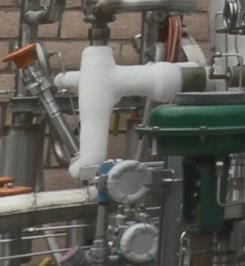Liquid Piping Systems
Ice formation on under insulated liquid hydrogen piping
The considerations described for Compressed Gas Piping Systems are applicable to liquid piping systems. This section discusses additional considerations for liquid systems.
Cryogenic liquid hydrogen piping systems should have minimum heat gain to reduce vaporization losses and to avoid formation of ice on the outside of piping due to condensation of water vapor. One good approach is to use vacuum-jacketed piping. The vacuum jacket should have its own pressure relief system to protect against leakage from the inner pipe. The presence of ice on the jacket generally indicates that a leak has occurred in the vacuum jacket.
Oxygen-rich air can be produced by contact with the outside of uninsulated liquid hydrogen piping and react with combustible materials. Precautions normally taken include:
- Insulation materials are non-combustible, i.e., plastic foam materials are avoided
- Because of the possibility of combustion of asphalt in an oxygen-rich environment, concrete paving is used in preference to asphalt in the liquid storage area where air condensation is a reasonable possibility due to the risk of fire from pure or liquid oxygen coming in contact with asphalt.
Pressure relief devices must be provided in piping wherever liquid hydrogen could be trapped between closures.
An automatic shut-off valve should be installed in liquid hydrogen withdrawal piping as close to the vessel as practical. NFPA 55 does not require that automatic shut-off valves be installed on tanks smaller than 2,000 gallons, but they are recommended for all tanks. There should not be any connections, flanges, or other appurtenances (other than a welded manual shut-off valve) allowed in the piping between the automatic shut-off valve and the tank.
Below-grade piping should be laid in open trenches with removable grating. Cryogenic liquid hydrogen piping should be insulated so it will not freeze the ground.
Piping systems must have sufficient flexibility to prevent fatigue failures caused by thermal contraction. For vacuum-jacketed piping, the jacket has to be designed to allow thermal contraction of the inner pipe.
For information on low-temperature concerns or material selection for cryogenic liquid hydrogen piping systems, please see Material Compatibility.
References
Air Products Safetygram for Liquid Hydrogen
ANSI/AIAA G-095, Guide to Safety of Hydrogen and Hydrogen Systems
NFPA 55, Compressed Gases and Cryogenic Fluids Code


